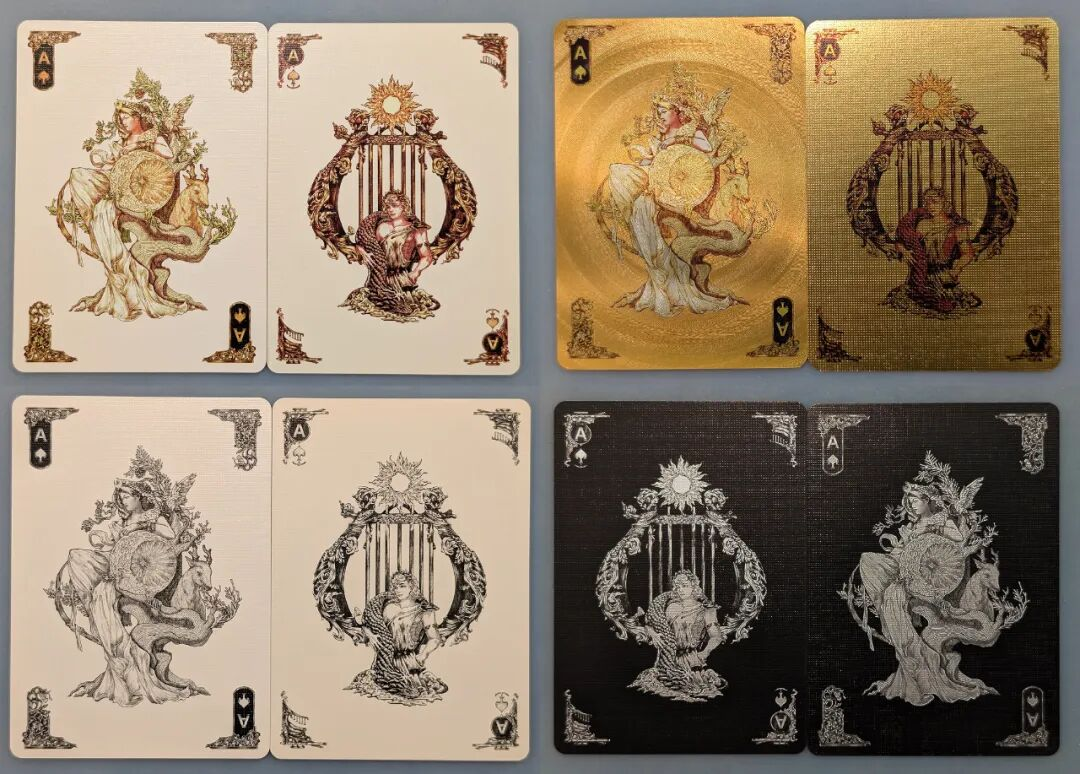When a deck's collector box is jokingly called a "Mooncake Box," you can't help but expect its "sister version" to arrive right on time for the Mid-Autumn Festival.
Coincidentally, that's exactly what happened.
The Mooncake Box: A Mid-Autumn Encounter Sparked by a Nickname
Rewind to 2024. When the Apollo luxury box set by ARK finally arrived in my hands, its heavy, round walnut box prompted friends in the community to unanimously give it a nickname full of oriental charm—the "Mooncake Box." It was a joke, of course, but it accurately captured its unique, full, and round shape. Unfortunately, Apollo shipped around the Dragon Boat Festival, far from the Mid-Autumn Festival.

Interestingly, more than a year later, Apollo's twin sister, the Moon Goddess Artemis, actually shipped at the end of August this year, arriving just on the eve of the Mid-Autumn Festival. The same round box, one Sun God, one Moon Goddess, meeting during this festival of reunion. This sense of ritual created by coincidence added a special mood to the unboxing moment.
This is no longer just a new deck unboxing; it feels more like a family reunion delayed by a year. Today, let's appreciate these "Sun and Moon Twins" from Mount Olympus together.
The Stage: A Miniature Amphitheater Built for Mythology
The proudest feature of this pair of works from ARK is undoubtedly the patented box structure named "ARK Case." It abandons the traditional flip or drawer design. Through four foldable curved rectangular paper pieces, assisted by hidden hinges and magnetic structures, it achieves a stunning 360° circular unfolding.

This structure not only perfectly echoes the themes of "Sun" and "Moon" in form but also presents a complete Baroque-style painting before your eyes the moment it unfolds. It is like a miniature mobile theater; every opening and closing is the curtain rise and fall of a myth. These two circular illustrations are the essence of the mythological stories told by the two decks of cards.
Apollo: The Creation Movement of the Sun God
This circular painting, dominated by red and gold, depicts the story of Apollo bestowing music and light upon the world. Its artistic core is "Expansion." As the god of light and art, his divinity is radiant, giving, and infinite. This painting captures this perfectly.
- Core Narrative & Composition: The core conflict and inspiration of the image come from Michelangelo's fresco The Creation of Adam. The painting cleverly reinterprets God's "touch of the fingertip" creating Adam into the moment Apollo passes the sun's brilliance, symbolizing divinity, to mortals. This is an extremely complex "Digital Baroque" style. There is almost no white space in the picture; countless details—giant pythons, chariots, classical architecture, flying sheet music—fill the entire circular space in an almost explosive manner, expressing the inexhaustible nature of divine creativity.

Color & Emotion: Large areas of red and brilliant gold establish the passionate, splendid, and sacred tone of the painting. It accurately conveys the creativity and passion brought by the Sun God's power as the god of light, poetry, and music.
Visual Experience: The whole picture feels "upward" and full of hope. Mortals reach out to the divine realm, expecting divine gifts, showing a classicism worship of gods and praise for the birth of art. The energy of the entire painting is centrifugal, erupting outward from the central sun, trying to break through the constraints of the frame. This is the perfect visual translation of the Sun God's divinity.
Artemis: The Jungle Judgment of the Moon Goddess
This painting, dominated by green and brown, tells a colder and more dramatic myth—the story of the hunter Actaeon being punished for glimpsing the Moon Goddess bathing. Contrary to her brother's infinite expansion, Artemis's artistic core is "Convergence." As the goddess of the hunt and the moon, her divinity is guarding, introverted, and bounded.
- Core Narrative & Composition: If Apollo is a grand Baroque symphonic poem, then Artemis is more like an exquisite Rococo stage play. The core scene of the picture is confined to a deep jungle. The intertwined tree trunks form a natural frame, "converging" the narrative into a specific private space—the goddess's sanctuary. This composition with an "indoor feel" reflects the goddess's inviolable sense of boundaries. The viewer's gaze unconsciously follows the Moon Goddess Artemis drawing her bow from above, looking down at Actaeon, who has been turned into a stag by her divine power, and the hounds tearing at him. This low-angle composition full of oppression is inspired by the Rococo painting The Swing, making the viewer feel as if they are there, feeling the majesty and judgment from the god.

Color & Emotion: Green and interlaced tree branches are the dominant elements of the picture, immediately setting the scene in a deep, mysterious jungle. Unlike Apollo's splendor, the tone here is more quiet and solemn, accurately matching Artemis's cold and inviolable side as the goddess of the hunt.
Visual Experience: Contrary to Apollo's "upward" feeling, the visual center of gravity of this painting is "downward." The goddess executes divine punishment above the clouds, and mortals suffer their fate in the jungle. The strong vertical relationship creates a sense of destiny and awe for the majesty of the gods. The nymphs and angels peeping in the forest add a mythological atmosphere to this scene. The energy of the entire painting is centripetal; everyone's gaze, actions, and fate converge on the moment of the goddess's judgment.
Oracle: The Brilliance and Whispers Hidden on the Cards
If the box is the prologue of the story, then the cards themselves are the carriers of the myth.
The court cards of both decks depict the twelve Olympian gods, with a gorgeous style and complex details. But what truly reflects the difference between the "Sun and Moon Twins" is their portrayal of core elements.
Apollo's Ace of Spades and Joker repeatedly feature the "Lyre," symbolizing his priesthood of music and poetry. The card design and foil stamping process do their utmost to be fiery and brilliant, full of solar energy.

Artemis's Ace of Spades and Joker revolve around the two core elements of "Bow and Arrow" and "Deer." The card back design is also ingenious, incorporating deer skulls, laurel branches, and falcons into the complex classical patterns, building a symmetrical and mysterious altar.

Even more interesting is the design of the moon symbol. According to the setting book, this unique moon pattern was actually inspired by a real crater named "Artemis" on the west side of Mare Imbrium on the moon. Through artistic processing, ARK reshaped it into a crescent moon and embellished it with meteorite craters turned into cross stars, which is both well-founded and aesthetically pleasing.

Echoes: Reflections on Craftsmanship, Cost, and Innovation
Rumor has it that ARK changed its printing partner earlier this year. Comparing the overall feel of the two decks together, Artemis is indeed noticeably slightly inferior, mainly reflected in the paper being slightly thinner and the snap/resilience being softer. Moreover, it is unavoidable that there are slight color differences between the corresponding versions of both Apollo and Artemis, which is a bit regrettable.

Another difference between Artemis and Apollo is the addition of Holo technology to the cards. To be honest, I don't particularly like the Holo effect, mainly because it creates a visual break in light and shadow when fanning. This is an unavoidable problem for Holo technology since playing cards are cut from large sheets.

There is also a topic that has caused heated discussion in the overseas community: the change of wood for the luxury box. Apollo used darker walnut, while Artemis switched to lighter European beech. Many people think this is ARK quietly cutting raw material costs. I have reservations about this.
First, this is not the first time ARK has used beech; the White Tiger box in the previous Four Beasts series also used beech. Second, from a visual matching perspective, light-colored beech indeed sets off Artemis's cold, elegant "moonlight" temperament better than heavy walnut. Therefore, I am more inclined to believe that this is a design choice based on aesthetics rather than purely a cost consideration.

Finally, an unavoidable point of controversy: the continuity of "innovation." Apollo's circular box structure truly amazed everyone when it came out last year. But a year later, when Artemis appeared with almost the exact same structure and even nearly identical court card designs, some doubts arose in the domestic community. Some enthusiasts believe this is more like a "reskin" creation rather than a true breakthrough, which seems to be at odds with ARK's consistent claim of "continuous innovation."
I have a different view on this. I think viewing Apollo and Artemis as two independent works that need to surpass each other may have deviated from the designer's original intention from the start. Their core concept is "Sun and Moon Twins"—symbiosis, mirroring, a natural pair. In this setting, the unity of structure and design language is the key to achieving their "paired sense." If Artemis had adopted a completely new structure, they would no longer be "twins" but two unrelated stories.
Therefore, I prefer to see this ingenious "ARK Case" as a dedicated stage created by the designer for this mythological series. The actors (themes) and scripts (scrolls) have changed, but the stage itself is the soul connecting all the stories. Innovation is reflected not only in the one-time subversion of structure but also in how to tell a new story that is equally wonderful but has a different flavor within a successful framework.
Completion: A Collection Spanning Time and Myth
From Apollo to Artemis, ARK spent two years completing a pair of truly stunning "sister pieces." They not only made pioneering attempts in structure but also showed a high degree of completion in the excavation and presentation of artistic themes.
Holding this pair of "Mooncake Boxes," it coincides with the Mid-Autumn Festival. The light of the sun and the brilliance of the moon are finally reunited in my collection cabinet at this moment. This satisfaction spanning time and myth is perhaps one of the most fascinating charms of playing card collecting.

So, do you prefer Apollo, representing the sun, or Artemis, symbolizing the moon? Or, how long do you think ARK can continue to output this kind of extreme structure and artistic design?
Feel free to share your thoughts in the comments section.